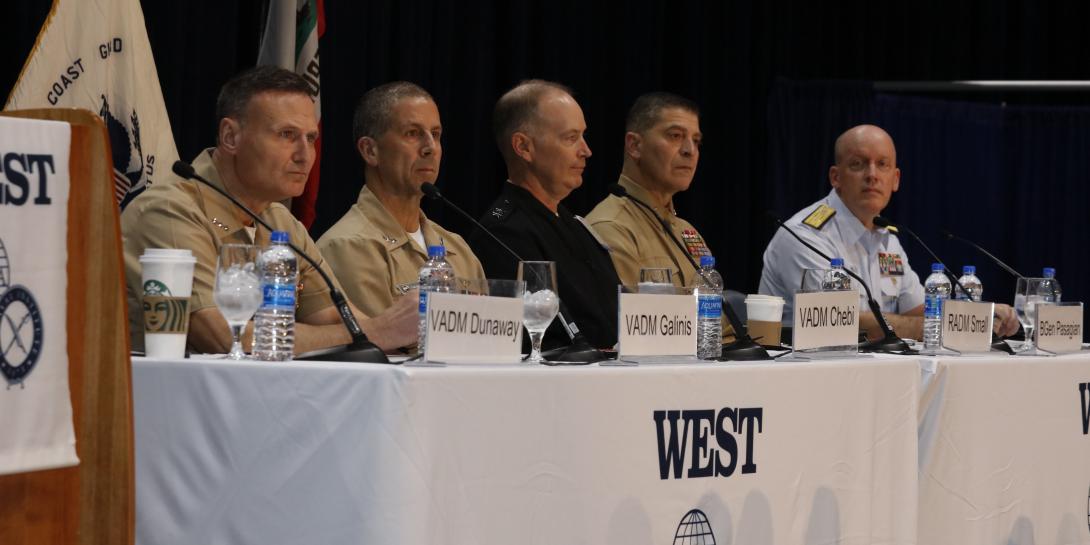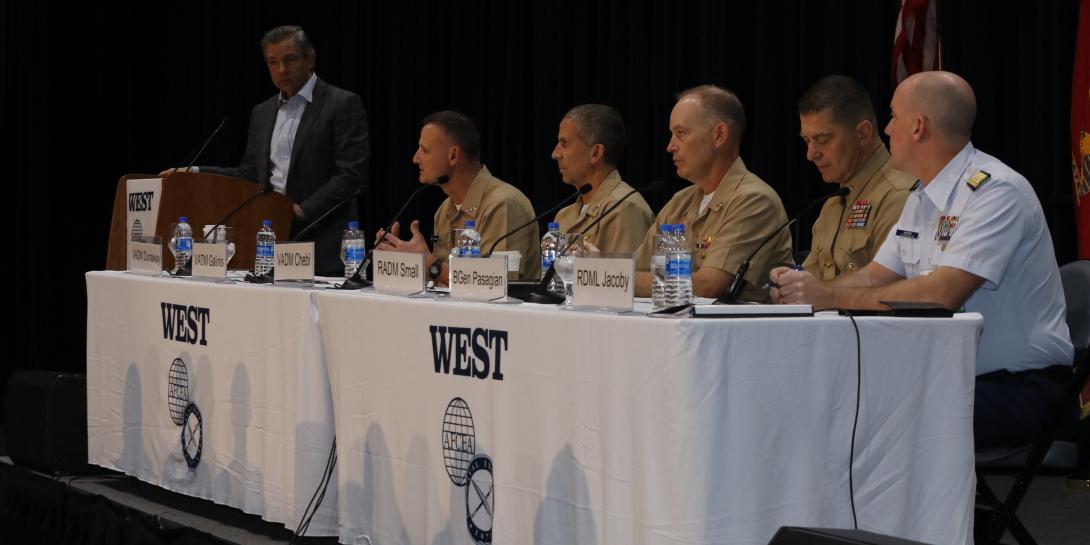Acquisition Angles
As it fields more advanced capabilities, the U.S. Navy, Marine Corps and Coast Guard are making changes to their acquisition processes, but the efforts are not without difficulties, system commanders from the services reported. Long-range fire missile systems, artificial intelligence, autonomy, 5G and C5I technologies require technical know-how as part of the acquisition process, and not just at the technical and engineering levels but also in the finance, contracting and human resource divisions, leaders said at WEST 2022, the conference and exposition hosted by AFCEA International and the U.S. Naval Institute in San Diego February 16-18.
“As we go forward the stakes have never been higher,” emphasized Vice Adm. David Dunaway, USN (Ret.), former commander, Naval Air Systems Command. “We are clearly in a position where we could get disrupted by others who are inserting technology faster than we are. With our acquisition process, we've all talked many, many times before about how bureaucratic it is, how slow it is, how cumbersome it is, but it is good people doing good things over a period of time that's going to make a difference.”
VADM David A. Dunaway, USN (Ret.)
— Kimberly Underwood (@Kunderwood_SGNL) February 17, 2022
Former Commander, Naval Air Systems Command: China and Russia present incredibly pressing problems. We need to do the best we can with agility and speed to field technologies. @NAVAIRNews @USNavy #WEST2022 @AFCEA
For Vice Adm. William Galinis, USN, commander, Naval Sea Systems Command, streamlining the acquisition process stems directly from workforce development. Given how technical or advanced some capabilities are, naval personnel across the whole acquisition process have to have a broad understanding of the solutions.
“When we think about improving the acquisition process, there's two fundamental areas that I challenge my team on,” he said. “One is improving the speed of decision making and the second is really to eliminate stop works. It applies in our part of the business as much as it does in acquisition and as it does in fleet maintenance. It really applies across the spectrum. And foremost, it starts with a trained and empowered workforce. Developing leadership competence and developing technical competence comes in many flavors. It is certainly technical, it's engineering, but it's also finance, contracting and human resources. And regardless of what part of the business you work in, you've really got to own that.”
VADM William Galinis, USN, Cmdr @NAVSEA @USNavy: No matter what line of business we are in, we have to improve our speed of decision making. It goes to technical competence in tech, engineering, finance & HR. Each of us has to own our part of the battle space #WEST2022 pic.twitter.com/HxvfhEKidh
— Kimberly Underwood (@Kunderwood_SGNL) February 17, 2022
To simplify processes, Adm. Galinis is working to combine closely related documents for decision makers, such as acquisition strategies and acquisition plans, as well as to drive down acquisition decisions to lower management levels, such as down to the program manager level, to cut out some of the bureaucracy.
The Coast Guard also sees a need to streamline its acquisition processes, especially as it undertakes considerable expansion, including into control, command, communications, computing, cyber and intelligence (C5I) capabilities, said Rear Adm. Chad L. Jacoby, USCG, director of acquisition programs and program executive officer, U.S. Coast Guard.
“The Coast Guard is entering into a period of massive shipbuilding, expanding the size of our 860-fleet and really getting after a lot of the C5I systems that have been neglected for years,” he said. “We have to figure out how to accelerate these programs moving through the acquisition portfolio.”
The @USCG is entering into a period of “massive” shipbuilding to expand the size of our fleet & getting after C5I systems, says RDML Chad L. Jacoby, Director of Acquisition programs & Program Executive Officer United States Coast Guard. #WEST2022 @AFCEA pic.twitter.com/G4RSORgTTo
— Kimberly Underwood (@Kunderwood_SGNL) February 17, 2022
The Coast Guard is taking a tiered approach, he continued. “We are trying to convince everybody that not everything is a 20-year shipbuilding program,” said Adm. Jacoby. “There's tier and different risk levels. The sea service has broken acquisition into four different governance structures, with some of the larger programs governed at the undersecretary level and other decided inside the Coast Guard at the flag level. A third tier is decided by 06-level Coast Guard officials and an even lower tier of level 3 limited programs can be decided upon quickly."
In addition, Vice Adm. Carl Chebi, USN, commander, Naval Air Systems Command, recognized that as the Navy is bringing in more complex solutions, the acquisition process requires a more comprehensive approach while aggressively pursuing speed to fielding.
“We are no longer fielding airplanes, we are no longer fielding weapons, and we are no longer fielding with networks,” he stated. “We are fielding integrated warfighting capability from seabed to space. So, partnerships across the project managers and the program executive officers, the system commands, the services and with industry, are all critically important for us to be successful.”
Adm. Chebi cites the example of fielding advanced long-range fire missile systems, which essentially involves the acquisition of systems of systems. “It is going to require us to train our workforce to think differently about the problem going forward and how we design, develop, test integrate and field that capability,” he said.
VADM Carl P. Chebi, Cmdr, Naval Air Systems Command@NAVAIRNews @USNavy:To field Long-Range fires, and systems of systems acquisitions, it is going to require us to train our workforce differently #WEST2022 @AFCEA pic.twitter.com/IFoh8E4Lsw
— Kimberly Underwood (@Kunderwood_SGNL) February 17, 2022
Regarding the acquisition of autonomous, artificial intelligence (AI) and other capabilities, Rear Adm. Douglas Small, USN, commander, Naval Information Warfare Systems Command, portended that it can be done, albeit with caution. “We're information warfare and we provide the connective tissue for those types of concepts, such as Mosaic, AI,” he stated. “And there's a lot that goes into that, whether it's for networks, or digital platforms or all the autonomy…. you have to be really smart about what capabilities you put in there to truly make them attritable. The thing we have to guard against is overly specifying [a solution].”
Our new playbook for how we execute acquisition resources was just approved, says BGen Arthur J. Pasagian, @USMC, Cmdr Marine Corps Systems Command @MCSC_Quantico. It will simplify & make clear who is doing what. #WEST2022 @AFCEA pic.twitter.com/Hd1tNg6hxJ
— Kimberly Underwood (@Kunderwood_SGNL) February 17, 2022
Meanwhile, the Marine Corps’ Marine Corps Systems Command (MCSC) has introduced a new acquisition playbook to help guide the service as it integrates more fully into a Fleet Marine Force with the Navy, explained Brig. Gen. Arthur Pasagian, USMC, commander of the MCSC.
Our new playbook for how we execute acquisition resources was just approved, says BGen Arthur J. Pasagian, @USMC, Cmdr Marine Corps Systems Command @MCSC_Quantico. It will simplify & make clear who is doing what. #WEST2022 @AFCEA pic.twitter.com/Hd1tNg6hxJ
— Kimberly Underwood (@Kunderwood_SGNL) February 17, 2022
“We were tasked by the commandant [Gen. Berger] to come up with a playbook for how we execute acquisition resources within the department,” the general shared. “How we conduct acquisition for a rifle is quite different from how we conduct acquisition for an amphibious warship, and a lot of those systems bleed over into NAVWAR. We wrote a playbook that is designed to simplify and make very clear who has the responsibility to do what in this behemoth of a bureaucracy. I'm happy to tell you that it's approved.”
The playbook, or Marine Corps Order (MCO) 5000.27, “clearly defines specific authorities, roles, and responsibilities,” MCSC Public Affairs Specialist Kelly Flynn told SIGNAL when asked to clarify about the newly approved effort. “It clarifies and streamlines service-level acquisition actions to deliver capability at the speed of relevance. The order allows us to leverage the maneuver space provided by the [Defense Acquisition University’s] Adaptive Acquisition Framework to increase tempo in acquisition operations wherever applicable and advantageous.”
Lastly, the leaders all agreed that industry will provide the key solutions to the Defense Department, instead of DoD leading in innovation. And that shift does require a robust private sector contribution. “It is also the strength of the industrial base,” Adm. Galinis noted. “We absolutely need a strong industrial base, and this is not just the prime contractors. This is all the way down to those second, third, and fourth tier suppliers.”




Comments